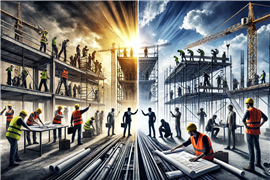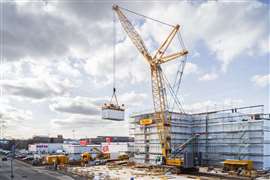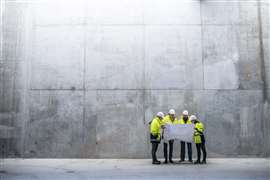Read this article in Français Deutsch Italiano Português Español
How AI is transforming construction contracts, risk, and compliance
11 February 2025
Josh Levy is the CEO and co-founder of Document Crunch, a technology company that provides AI-powered contract review and risk identification tools for the construction industry.
 A creative illustration showing how the office and construction site are becoming one in a new technological age. (Image generated by AI)
A creative illustration showing how the office and construction site are becoming one in a new technological age. (Image generated by AI)
Levy – who started his professional career in construction as a project engineer intern – has a background and degree in law and, before founding Document Crunch in 2021, worked as a contracting lead director and senior legal counsel for large construction outfits.
In simplest terms, construction firms relied on Levy’s understanding of the law, language, and contracting to ensure they submitted the right bids and delivered on existing expectations.
In an interview with Construction Briefing, Levy discussed the importance of understanding the contract in construction and considered the future of the industry with the advent of AI-powered tools and software.
How is Document Crunch prioritising the contract in modern construction?
When I think about the relative importance of what we’re doing, we identify as people that are running contracts. So, the contract is really at the core of everything.
 Josh Levy, Document Crunch
Josh Levy, Document Crunch
It’s at the core of every workflow that construction is based upon. It’s at the core of every stakeholder that has an interest in construction; I like to say, almost like rebar is foundational to a building structure, so is the contract to construction.
I kind of knew that, intuitively, having worked as an attorney and an executive in the construction industry my entire career, it just became apparent to me that there were really two conditions that I saw going on, which led to the founding of Document Crunch.
First and foremost, the contract is like the mini law of any construction project, so what that contract says is critically important. And so many people in our industry were signing up for contracts really without truly understanding what they were signing up for.
Whether you’re a big company or a small company, in the event that something invariably happens on a job site, what course of action to take is completely governed by the contract. And it’s something like 50% of projects overrun on time and cost.
But the folks that are running job sites every day are not always aware of what they need to do, and the failure to do the thing that you are required to do costs our industry a lot of money.
I’ll give you an example. Let’s say that [you’re a contractor and] you paid me US$700 to negotiate a fair contract for you that said that your company would get delay entitlement if it rained. Sounds like a great thing; you would have patted me on the back and said, ‘Thank you.’
But if it rained and the folks in the field – who likely weren’t in the room with you and I when that contract was getting negotiated – didn’t know that they got entitlement when it rained, or they didn’t know the right notice to give when it rained, or they were not confident in what to do when it rained, you may very well be left holding the bag for the ‘Pay More Than You Thought You Would’ Sweepstakes, which – otherwise – you didn’t even have to pay for if you had administrated the contract the right way.
So, Document Crunch is really in existence for both of those problem sets. It’s most rudimentary at core: We’re helping people understand contracts before they sign up, and, being aware of where risks are.
But, much more profoundly, we’re also protecting like a digital hard hat, project teams as they go through all of these workflows every day.
Are construction contracts are getting more complicated do people need tools like AI just to understand the basics?
 A creative digital illustration depicting a construction site where a legal contract is being ‘built’ like a physical structure. (Image generated using AI)
A creative digital illustration depicting a construction site where a legal contract is being ‘built’ like a physical structure. (Image generated using AI)
Yes, yes and yes.
First and foremost: undoubtedly contracts have become more complicated. The easiest way to explain that phenomenon is the proliferation of new delivery methods for construction over the last 30 years.
You could start with design-build, but then you could go into public-private partnerships.
You could go into IPD [integrated product delivery], you could go into EPC [engineering, procurement, construction]. So, the form of contracting, or I should say the form of delivery, has certainly progressed at quite a clip over the last several years.
The advancements in technology have further blurred the lines; a lot of construction companies have software or teams in place that start to look a lot like what you would’ve thought a designer would traditionally have done.
I guess as construction delivery has become more complex, the contracts have similarly become more complex.
I also think that, in general, construction has become a real cottage industry, moving away from standardisation. And as private development, in particular, has become more and more prominent.
But I think the overarching macrocondition would be as delivery methods have become more complex, contracts have become more complex.
When our industry was a little bit simpler in delivery methods (and maybe a little bit even smaller), you’d hear from folks in the industry that the project executive and the superintendent used to sit in the job trailer with coffee stains and cigarette butts on their contract, and they would do a page turn, right?
When you add in a labour shortage, which is a lot of the older generation is now moving on, a lot of that subject matter expertise is going out with it. You are definitely seeing that.
Finally – and this is really interesting – when I started this industry, and when I graduated as a construction management major in 2005, we were still sending notices vis-a-vis fax. And, in the generation before that, we were sending notices via letters. Due to technology and the speed and velocity of communication expectations, the typical project team is just so much more inundated now with more complex contracts, less knowledge transfer, and the velocity of information and expectations of responses that it’s become a very big tangled mess of complexity.
This is exactly the type of condition that is ripe for a technology like AI to come in and, in our case, almost serve as like a digital hardhat. This stuff is hard. You’re going to bump up on some intense issues, but if we can soften the blow, that’s good.
Can you walk me through the life of construction contract and how modern tech is assisting the process?
Let’s start with pre-construction.
 Construction workers in an office setting. (Image: Adobe Stock)
Construction workers in an office setting. (Image: Adobe Stock)
First, Document Crunch is known as a contract software, but the reality is we’re called Document Crutch: We’re crunching a lot more than just the contracts.
We’re crunching what I’ll call all the contract documents, which comprise other things, too.
So, you’re bidding a job, oftentimes you want to know what risk is in a job before you bid it. [Our software] can be used to very quickly identify problematic contract terms… or to break down those documents for common risks or issues that would impact them as well.
For example, maybe the business development team wants to sign an NDA before even getting the bid. [The software] can help break down NDAs.
So, we’re crunching all these documents and allowing the user a very high-level view into where the risks are.
But our platform works very collaboratively so that whether you’re a pre-construction professional, risk management, professional, legal, a project executive, a business developer, you name it, they can all collaborate and not only like see where the risks are but can track those risks and formulate mitigation plans or the appropriate approvals needed before proceeding.
Now, we’ve been awarded the job, and it’s time to negotiate the contract. Document Crunch also is a tool that facilitates and helps automate the red lining and negotiation of contracts.
Now you’ve signed the contract, and it’s time to start construction. The guys wearing hard hats have to understand what they need to administer or where the important issues are that they need to adhere to. Document Crunch can generate an automated project team playbook, which, during construction, things are happening every single day while you and I are on the phone right now, a project team is in the job trailer getting yelled at by the owner about what’s allowable markup or a superintendent’s walking the job site and wants to understand what rebar has been specified before the concrete is poured.
We have the ability to help impact daily decision-making for project teams by one, having a, you know, open kind of chat search feature so that you can get very quick answers to any questions that you have in your contract documents, not just the contract, but also contract documents.
Two, we’ve started automating jobs to be done for construction teams. For example, we launched our automated notice builder, so now teams in two minutes can give a contractually compliant notice using our platform.
 An illustration showing high-tech contracting software combined with a construction job site. (Image generated by AI)
An illustration showing high-tech contracting software combined with a construction job site. (Image generated by AI)
The industry needs to realise that high-tech is needed in the office, too, right?
I think our industry sometimes gets the bad reputation.
Here’s the deal, and I mean this wholeheartedly: Modern construction technology has completely flipped the way our industry is working in this most important foundational space, the contract.
I’m really proud as a construction guy, and I’m sick and tired of hearing that construction is slow to adopt technology. I’m not seeing that. We have made a significant dent in changing how our industry works, and we will continue. And I actually think the construction industry is at the forefront of innovation.
STAY CONNECTED


Receive the information you need when you need it through our world-leading magazines, newsletters and daily briefings.
CONNECT WITH THE TEAM














